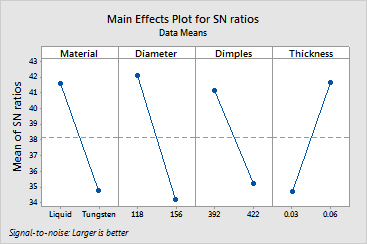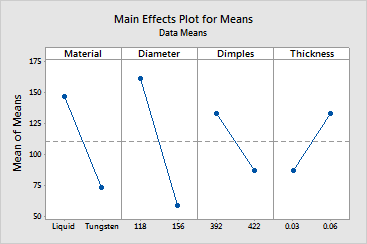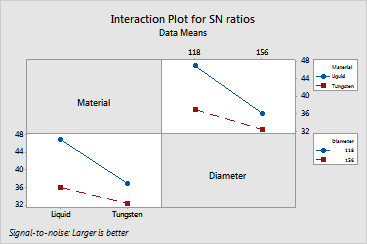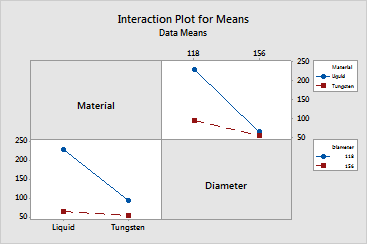main topic interpreting results session command see also
You manufacture golf balls and are working on a new design to maximize ball flight distance. You have identified four control factors, each with two levels:
You also want to test the interaction between core material and core diameter.
The response is ball flight distance in feet. The noise factor is two types of golf clubs: driver and a 5-iron. You measure distance for each club type, resulting in two noise factor columns in the worksheet. Because your goal is to maximize flight distance, you select the larger-is-better signal-to-noise (S/N) ratio.
1 Open the worksheet GOLFBALL.MTW. The design and response data have been saved for you.
2 Choose Stat > DOE > Taguchi > Analyze Taguchi Design.
3 In Response data are in, enter Driver and Iron.
4 Click Analysis.
5 Under Fit linear model for, check Signal-to-noise ratios and Means. Click OK.
6 Click Terms.
7 Verify that A:Material, B:Diameter, C:Dimples, D:Thickness, and AB are in Selected Terms. Click OK.
8 Click Options.
9 Under Signal to Noise Ratio, choose Larger is better. Click OK in each dialog box.
Session window output
Taguchi Analysis: Driver, Iron versus Material, Diameter, Dimples, Thickness
Linear Model Analysis: SN ratios versus Material, Diameter, Dimples, Thickness
Estimated Model Coefficients for SN ratios
Term Coef SE Coef T P Constant 38.181 0.4523 84.418 0.000 Material Liquid 3.436 0.4523 7.596 0.017 Diameter 118 3.967 0.4523 8.772 0.013 Dimples 392 2.982 0.4523 6.593 0.022 Thicknes 0.03 -3.479 0.4523 -7.692 0.016 Material*Diameter Liquid 118 1.640 0.4523 3.625 0.068
S = 1.279 R-Sq = 99.2% R-Sq(adj) = 97.2%
Analysis of Variance for SN ratios
Source DF Seq SS Adj SS Adj MS F P Material 1 94.427 94.427 94.427 57.70 0.017 Diameter 1 125.917 125.917 125.917 76.94 0.013 Dimples 1 71.133 71.133 71.133 43.47 0.022 Thickness 1 96.828 96.828 96.828 59.17 0.016 Material*Diameter 1 21.504 21.504 21.504 13.14 0.068 Residual Error 2 3.273 3.273 1.637 Total 7 413.083
Linear Model Analysis: Means versus Material, Diameter, Dimples, Thickness
Estimated Model Coefficients for Means
Term Coef SE Coef T P Constant 110.40 8.098 13.634 0.005 Material Liquid 36.86 8.098 4.552 0.045 Diameter 118 51.30 8.098 6.335 0.024 Dimples 392 23.25 8.098 2.871 0.103 Thicknes 0.03 -22.84 8.098 -2.820 0.106 Material*Diameter Liquid 118 31.61 8.098 3.904 0.060
S = 22.90 R-Sq = 97.9% R-Sq(adj) = 92.6%
Analysis of Variance for Means
Source DF Seq SS Adj SS Adj MS F P Material 1 10871 10871 10870.8 20.72 0.045 Diameter 1 21054 21054 21053.5 40.13 0.024 Dimples 1 4325 4325 4324.5 8.24 0.103 Thickness 1 4172 4172 4172.4 7.95 0.106 Material*Diameter 1 7995 7995 7994.8 15.24 0.060 Residual Error 2 1049 1049 524.6 Total 7 49465
Response Table for Signal to Noise Ratios Larger is better
Level Material Diameter Dimples Thickness 1 41.62 42.15 41.16 34.70 2 34.75 34.21 35.20 41.66 Delta 6.87 7.93 5.96 6.96 Rank 3 1 4 2
Response Table for Means
Level Material Diameter Dimples Thickness 1 147.26 161.70 133.65 87.56 2 73.54 59.10 87.15 133.24 Delta 73.73 102.60 46.50 45.68 Rank 2 1 3 4 |
Graph window output




Each linear model analysis provides the coefficients for each factor at the low level, their p-values and an analysis of variance table. Use the results to determine whether the factors are significantly related to the response data and each factor's relative importance in the model.
The order of the coefficients by absolute value indicates the relative importance of each factor to the response; the factor with the biggest coefficient has the greatest impact. The sequential and adjusted sums of squares in the analysis of variance table also indicate the relative importance of each factor; the factor with the biggest sum of squares has the greatest impact. These results mirror the factor ranks in the response tables.
In this example, you generated results for S/N ratios and means. For S/N ratios, all the factors and the interaction terms are significant at an a-level of 0.10. For means, core material (p=0.045), core diameter (p=0.024), and the interaction of material with diameter (p=0.06) are significant because their p-values are less than 0.10. However, because both factors are involved in the interaction, you need to understand the interaction before you can consider the effect of each factor individually.
The response tables show the average of each response characteristic (S/N ratios, means) for each level of each factor. The tables include ranks based on Delta statistics, which compare the relative magnitude of effects. The Delta statistic is the highest minus the lowest average for each factor. Minitab assigns ranks based on Delta values; rank 1 to the highest Delta value, rank 2 to the second highest, and so on. Use the level averages in the response tables to determine which level of each factor provides the best result.
In this example, the ranks indicate that core diameter has the greatest influence on both the S/N ratio and the mean. For S/N ratio, cover thickness has the next greatest influence, followed by core material and dimples. For means, core material has the next greatest influence, followed by dimples and cover thickness.
For this example, because your goal is to increase ball flight distance, you want factor levels that produce the highest mean. In Taguchi experiments, you always want to maximize the S/N ratio. The level averages in the response tables show that the S/N ratios and the means were maximized when the core was liquid, the core diameter was 118, there were 392 dimples, and the cover thickness was .06. Examining the main effects plots and interaction plots confirms these results. The interaction plot shows that, with the liquid core, the flight distance is maximized when the core diameter is 118.
Based on these results, you should set the factors at:
|
Material |
Liquid |
|
Diameter |
118 |
|
Dimples |
392 |
|
Thickness |
.06 |
Next, you may want to use Predict Results to see the predicted S/N ratios and means at these factor settings. See Example of predicting results.